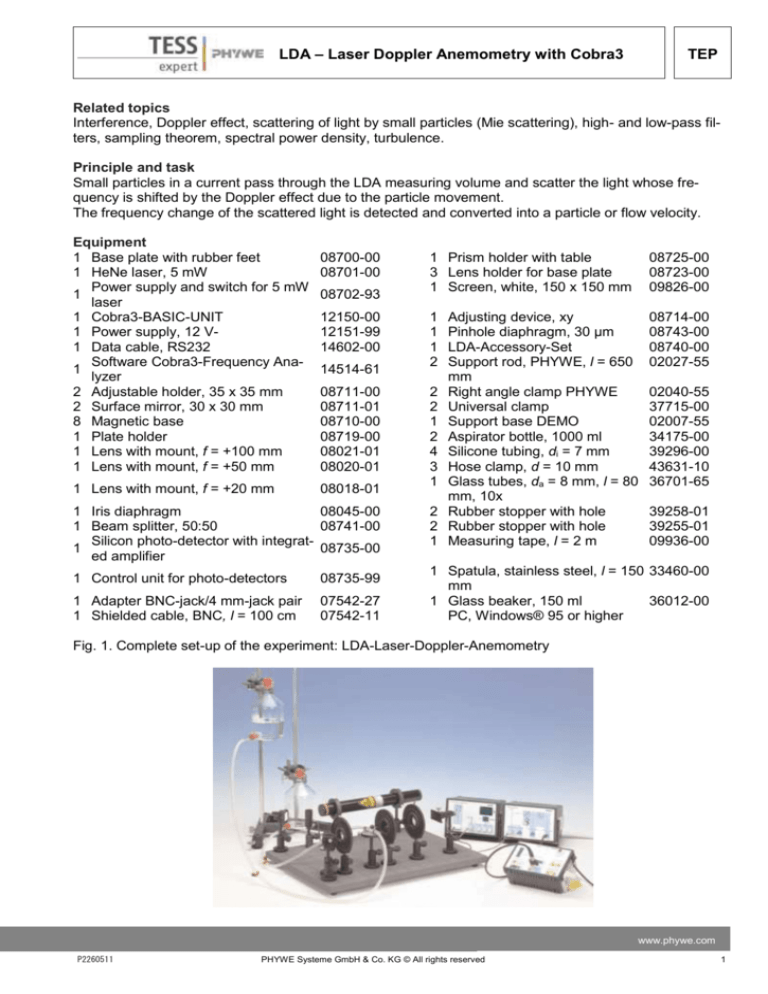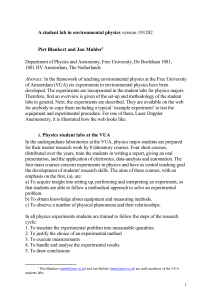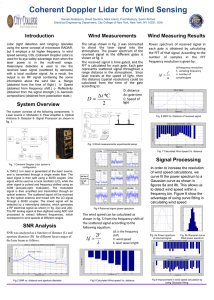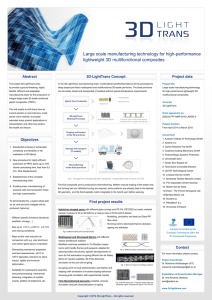
LDA – Laser Doppler Anemometry with Cobra3
TEP
Related topics
Interference, Doppler effect, scattering of light by small particles (Mie scattering), high- and low-pass filters, sampling theorem, spectral power density, turbulence.
Principle and task
Small particles in a current pass through the LDA measuring volume and scatter the light whose frequency is shifted by the Doppler effect due to the particle movement.
The frequency change of the scattered light is detected and converted into a particle or flow velocity.
Equipment
1 Base plate with rubber feet
1 HeNe laser, 5 mW
Power supply and switch for 5 mW
1
laser
1 Cobra3-BASIC-UNIT
1 Power supply, 12 V1 Data cable, RS232
Software Cobra3-Frequency Ana1
lyzer
2 Adjustable holder, 35 x 35 mm
2 Surface mirror, 30 x 30 mm
8 Magnetic base
1 Plate holder
1 Lens with mount, f = +100 mm
1 Lens with mount, f = +50 mm
1 Lens with mount, f = +20 mm
08700-00
08701-00
08702-93
12150-00
12151-99
14602-00
14514-61
08711-00
08711-01
08710-00
08719-00
08021-01
08020-01
08018-01
1 Iris diaphragm
08045-00
1 Beam splitter, 50:50
08741-00
Silicon photo-detector with integrat1
08735-00
ed amplifier
1 Control unit for photo-detectors
08735-99
1 Adapter BNC-jack/4 mm-jack pair
1 Shielded cable, BNC, l = 100 cm
07542-27
07542-11
1 Prism holder with table
3 Lens holder for base plate
1 Screen, white, 150 x 150 mm
08725-00
08723-00
09826-00
1
1
1
2
08714-00
08743-00
08740-00
02027-55
2
2
1
2
4
3
1
2
2
1
Adjusting device, xy
Pinhole diaphragm, 30 µm
LDA-Accessory-Set
Support rod, PHYWE, l = 650
mm
Right angle clamp PHYWE
Universal clamp
Support base DEMO
Aspirator bottle, 1000 ml
Silicone tubing, di = 7 mm
Hose clamp, d = 10 mm
Glass tubes, da = 8 mm, l = 80
mm, 10x
Rubber stopper with hole
Rubber stopper with hole
Measuring tape, l = 2 m
02040-55
37715-00
02007-55
34175-00
39296-00
43631-10
36701-65
39258-01
39255-01
09936-00
1 Spatula, stainless steel, l = 150 33460-00
mm
1 Glass beaker, 150 ml
36012-00
PC, Windows® 95 or higher
Fig. 1. Complete set-up of the experiment: LDA-Laser-Doppler-Anemometry
www.phywe.com
P2260511
PHYWE Systeme GmbH & Co. KG © All rights reserved
1
TEP
LDA – Laser Doppler Anemometry with Cobra3
Task
Measurement of the light-frequency change of individual light beams which are reflected by moving particles.
Set-up and procedure
In the following, the pairs of numbers in brackets refer to the coordinates on the optical base plate in accordance with Fig. 2.
These co-ordinates are only intended to help with coarse adjustment.
Perform the experimental set-up according to Fig. 1 and Fig. 2.
The recommended set-up height (beam path height) is 130 mm.
Initial operation of Cobra3:
Start the “measure“-software and select the “Frequency Analysis“ mode. Cobra3 must have been
switched on before the program is started. Connect the output of the control unit for the photodetector in
the ANALOG IN2 input of Cobra3. For this use the shielded BNC cable and the adapter (BNCSocket/4mm plug pair). Connect the adapter to + and GND, take the polarity of the adapter into account.
Preparing the liquid:
To begin with mix only a small quantity of distilled water (approximately 10 ml) with a spatula-tip full of
silver-coated glass beads in a small vessel. Fill an aspiration bottle, whose lower drain has already been
connected to a piece of silicone tubing sealed with a hose clamp, with a quantity of water approximately
equal to 500 ml in which approximately 2 to 3 ml of the previously prepared concentrated solution with
scattering particles is given. To kill bacteria, it is advisable to add a few drops of formaldehyde (30%).
Setting up the liquid reservoir:
Provide the support base with both support rods (l = 650 mm). Attach the glass bottles to the support
rods by clamping one of the universal clamps on each of the bottle necks and then using the right-angle
clamps to connect them to the rods (see Fig. 1).
In the same manner as already performed on the first bottle, now also equip the lower drain hole of the
second one with a piece of silicone tubing, which is sealed with a hose clamp to begin with. The pieces
of silicone tubing have been slipped onto glass tubes which have been inserted into rubber stoppers.
These, in turn, have been stuck into the lower openings of the aspiration bottles. The upper openings of
the aspirations bottles are also to be sealed with a rubber stopper to minimise the transfer of dust into
the liquid.
Setting up the optical components:
First, adjust the mirrors M1 [1,8] and M2 [1,1.5] such that the laser beam runs parallel to the 2nd y coordinate on the base plate.
Position the beam splitter BS [1,2.5] with its magnetic base close to mirror M2. While doing so, ensure
that the reflected partial beam also runs parallel to the 2nd y co-ordinate on the base plate. The metallized side of the beam splitter faces in the direction of M1. The beams, one of which emanates from the
beam splitter and the other of which from the mirror M2, must always maintain the same separation along
the travelling path! Check this with a measuring tape by holding it in the beam path at different distances
from M2 and BS. The separation should not be greater than 3 cm.
Now place the lens L1 (𝑓 = +100 𝑚𝑚) at position [2,2] such that the two parallel beams strike the lens
(symmetrically to the centre of the lens).
Adjusting the intersection point:
By inserting the lens L1 the two beams are made to cross at a distance of 10 cm (at position [4,2]) behind
the lens. For fine adjustment use the following arrangement:
Fix the pinhole diaphragm (diameter: 30 𝜇m) in an xy adjusting device that is, in turn, equipped with a
stem and inserted into a magnetic base. The screen SC at position [11,2] (not displayed in Fig. 2!)
serves as an observation screen. Now, set up the pinhole diaphragm at position [4,2] such that it is located in beam path height and exactly in the region of the intersection point of the two beams. Shift its
2
PHYWE Systeme GmbH & Co. KG © All rights reserved
P2260511
LDA – Laser Doppler Anemometry with Cobra3
TEP
position with the adjusting screws of the device in such a manner that the light spot (with diffraction phenomena) which previously emanated from the non-adjustable beam splitter BS appears on the screen
SC to the right of the optical axis. Now, alter the second beam, which emanates from mirror M2 by finely
adjusting mirror M2 such that this beam also passes through the pinhole diaphragm. A second luminous
spot (with diffraction phenomena) appears on screen SC, which now is located to the left of the optical
axis. Interference stripes can also be seen between the two light spots.
Fig. 2. Experimental set-up for laser-Doppler anemometry
Qualitative examination of the interference region:
Whether an interference region exists at the intersection point of the two beams, can be qualitatively
tested by reproducing this point with a second lens L2 (𝑓 = +20 mm). At a distance of 2 cm from the intersection point, set up L2 at position [4.5, 2] (This cannot be seen in Fig. 1 or Fig. 2!). On a distant observation plane (wall at a distance of at least 4 m or screen SC, which has been turned on its axis perpendicular to the optical axis to expand the light point which is to be observed, Fig. 3), two lights spots
appear. They can be made to coincide by readjusting mirror M2.
On closer examination of the illuminated area, one sees the interference fringes (example: at screen SC
distance of 113 cm, the luminous spot has a diameter of 8 mm). Now, remove the optical components L2
and the screen SC.
Determination of the interference half-angle 𝜑:
At a distance of approximately 2 to 3 meters, two luminous spots can be observed, which have made to
cross by lens L1 at the focus, 10 cm behind the lens. Now, measure the distance l ’ between lens L1 and
the observation plane and the distance of the two light spots D (see Fig.4). The distance of the intersection point to the observation plane l is determined by the difference 𝑙 ’ − 𝑓 = 𝑙.
www.phywe.com
P2260511
PHYWE Systeme GmbH & Co. KG © All rights reserved
3
TEP
LDA – Laser Doppler Anemometry with Cobra3
Fig. 3. Schematic set-up for the reproduction of the interference region of the crossed laser beams
Fig. 4. Schematic presentation of the set-up for the determination of the overlap half-angle 𝜑
Setting up the capillary and the bypass:
In order to keep the flow velocity in the region suitable for this experiment, the capillary tube from the
LDA accessory set is introduced into the hose. Since it is necessary from time to time to have a fast exchange of the liquid from one bottle to the other, the capillary is bypassed with a piece of hose that is
kept close with a hose clamp during the actual measurement. The set up of this part that also uses the
two Y-connectors from the LDA-accessory set can be seen in detail in Fig. Xa
Setting up the cell:
Pull the two O-rings each approximately 10 cm over the ends of the two pieces of silicone tubing, which
have already been connected to the glass bottle respectively the capillary/bypass unit with their other
ends. Subsequently, cautiously press these ends of the silicone tubing with twisting movements onto the
4
PHYWE Systeme GmbH & Co. KG © All rights reserved
P2260511
LDA – Laser Doppler Anemometry with Cobra3
TEP
cell so that they extend approximately 1 cm onto the cell (see Fig. 5). Now, slip the O-rings onto the connection locations of the silicone tubing’s ends and the cell to fix it.
Caution: The cell is made of quartz and very fragile. Therefore, handle it carefully! After connecting the
cell to the two pieces of silicone tubing, clean the finger prints and traces of grease from the cell with a
soft cloth! Clamp the cell to the prism table with the fixing ball. The laser beam must strike the parallel
cell walls perpendicularly! Now, place the prism holder with cell in the laser beam at position [4,2] such
that the beams pass through the lateral surfaces of the cell and that the intersection point of the two
beams is located in the middle of the cell (This can be best seen when the cell is filled with liquid!).
In the following, a flow of liquid through the cell should occur even when the hose clamp at the liquid
reservoir is opened. To achieve this, the filled glass bottle must be attached to the upper end of the support rod and the empty one, fixed at the lower position. For the fine adjustment of the flow velocity the
height difference of the two bottles can be varied.
Positioning the photo-detector D:
Position an iris diaphragm B, whose aperture is reduced until the two main beams are not able to pass
through it, in a lens holder behind the cell [5,2]. A lens L2 [7,2], with the focal length 𝑓 = +50 𝑚𝑚, focuses the scattered light which emerges parallel from the cell onto the photo-detector D [8,2]. The signal
from the photo-detector D is applied to a control unit, which amplifies and filters the signal.
This signal on the output of the control unit is applied to the input port IN2 on the Cobra3 interface (+ and
GND).
Presettings of the measuring program:
Press the red <New measuring> -button; now the setting parameters, such as the scanning frequency,
the trigger condition and the voltage range can be set.
Make the following settings:
the voltage range 𝑈𝑁 is ±10 V,
the frequency range 𝑓/kHz is 22.05
Fig. 5. Set-up diagram ”glass cell”
www.phywe.com
P2260511
PHYWE Systeme GmbH & Co. KG © All rights reserved
5
TEP
LDA – Laser Doppler Anemometry with Cobra3
Continuously both, the signal and the spectrum are displayed, when the parameters are set according to
Fig. 6. During aligning the set-up, it is recommended to select the “Measurement continuous” mode. During the fine adjustment do not press the <Save> or the <Close> buttons.
Now, the fine adjustment of the photo-detector D can be performed.
Adjust it with its input opening positioned at the focus of the 2nd lens L2 such that the time signal 𝐹(𝑡) exhibits its greatest voltage variations (upper diagram).
Occasionally, so-called bursts, which show an undulation with a high frequency, should be visible. This is
what you are looking for.
Shift the filled glass container to the upper position and the empty one to the lower position (see Fig. 1).
The flow can be observed due to the scattering of light in the cell (flashing of the scattering particles on
flowing through the measured volume). In the process, the level of the liquid sinks only very slowly; thus,
several minutes are available for the measurement.
On observing the spectrum 𝐺(𝑓) (lower diagram), a measuring signal peak must now emerge from the
background noise (see Fig. 7). The operating mode “Measurement continuously” off is recommended
now. You can start a new measurement by clicking the “Measure” button! Repeat this until you get a
“good” measurement signal, as you can see in Fig. 7.
At low flow velocities it is possible for the signal peak to move too far into the region of the direct current
fraction on the spectrum (𝑓~ 0 Hz); in such cases it can only be localised with difficulties.
Try different filter selections of the control unit for the photo detector.
At excessively high flow velocities turbulence may occur in the cell such that the result could be falsified
by excessively great differences in the particle velocities. In addition, it is possible for a signal peak with
higher frequency to be mirrored at the highest frequency location of the measured spectrum due to a
property of the FFT algorithm, and thus still be visible. This case can be recognised by a shift of the signal peak to higher frequencies instead of lower ones when the current velocity slows (due to the unavoidable sinking of the liquid level). In this case select a higher sampling frequency!
Fig. 6. Appearance of the program desktop. Display of the time signal 𝐹(𝑡) (upper curve) and the spectrum 𝐺(𝑓) (lower curve) of the photo-detectors voltage
6
PHYWE Systeme GmbH & Co. KG © All rights reserved
P2260511
LDA – Laser Doppler Anemometry with Cobra3
TEP
When you have got a “good“ signal, press the <Save> button.
By means of the survey function (#), the mean frequency of the signal peak can be directly determined
(display of the frequency below the signal display). See Fig. 8.
The velocity measurement (i.e., the determination of the mean frequency of the signal peak in the spectrum) is now performed at different flow velocities. To do this you can vary the height difference between
the two bottles.
Relevant information
The scattering bodies (glass beads coated with silver) sediment out after a few hours. Therefore, they
should be returned to solution by shaking the liquid at regular intervals (every half hour)! Additionally, to
also bring the glass beads that sedimented in the hose back to the solution, let the liquid run quickly
through the open bypass from one bottle to the other.
The general background illumination should be kept as low as possible so that the signal peak in the
spectrum is more easily seen.
Fig. 7. Measurement of the signal spectrum with a signal peak at 2344 Hz
www.phywe.com
P2260511
PHYWE Systeme GmbH & Co. KG © All rights reserved
7
TEP
LDA – Laser Doppler Anemometry with Cobra3
Fig. 8. Measurement of the signal spectrum with a signal peak
8
PHYWE Systeme GmbH & Co. KG © All rights reserved
P2260511
LDA – Laser Doppler Anemometry with Cobra3
TEP
Theory and Evaluation
Doppler effect
Two cases of the Doppler effect are used to discuss the LDA principle (see Fig. 9).
a) In the first case, a stationary light source and a moving receiver are present, where the velocity of the
receiver is given by the vector . The light frequency at the receiver fR is given in the following manner
as a function of the transmission frequency fs at the light source:
𝑓R = 𝑓𝑠 (1 −
⃑ . 𝑙
𝑈
)
𝑐
(1)
where c is the speed of light in air.
b) In the second case a moving light source is used and the receiver is stationary. Thus, the received
light frequency is given as follows:
𝑓R =
𝑓𝑠
(1−
⃑
⃑⃑⃑ . 𝑘
𝑈
)
𝑐
(2)
In LDA a laser is used as a stationary light source and small, flowing particles scatter the light, which is
then received by a photodiode D.
www.phywe.com
P2260511
PHYWE Systeme GmbH & Co. KG © All rights reserved
9
TEP
LDA – Laser Doppler Anemometry with Cobra3
The application of the two upper equations (1-2) provide the frequency of the light at the photocell after
the laser light has been scattered by the moving particles and received by the stationery receiver (see
Fig. 10):
𝑓R = 𝑓𝑠 (1 −
⃑ . 𝑙
⃑ . ⃑𝑘
𝑈
𝑈
) ⁄(1 −
)
𝑐
𝑐
(3)
Twin beam anemometer
In the practical application, only a small Doppler shift of the light frequency due to the movement of the
particles results, as follows from Equation (3), compared to the light’s frequency. Thus, a direct measurement of the frequency (e.g. with the aid of a Fabry-Perot interferometer) can only be performed with
insufficient accuracy.
There are different methods of avoiding a direct optical frequency measurement:
Fig. 9. Two cases for the discussion of the Doppler-effect
Due to the quadratic characteristic line of the photo-detector, it is possible to mix two light frequencies.
Thus, the beat frequency of the two signals can be detected. For example, in the selfbeating method, the
frequency-shifted signal is mixed with itself (as measuring frequency, one obtains twice the difference
frequency).
Additional methods are the homodyne (one light source) and the heterodyne (two light sources) mixing.
In the arrangement presented here, the twin-beam configuration (two crossed beams from the same light
source) is used (see Fig. 4).
In this arrangement, a laser beam is split into two partial beams having equal intensities, which are then
focused in the measuring control volume (mcv) and made to intersect within this volume.
10
PHYWE Systeme GmbH & Co. KG © All rights reserved
P2260511
LDA – Laser Doppler Anemometry with Cobra3
TEP
Particles in the flow which passes through this overlap volume scatter the light of both partial beams.
The Doppler shift of the scattered light is different for the two partial beams (different vectors, but the
same vectors).
This difference, generally known as the beat frequency, is measured in the scattered light. This frequency difference is designated as the Doppler frequency and is substantially lower-frequency and has a narrower band width as the source frequency of the light. Thus, an exact detection and measurement
of this frequency with electronic means is possible. Now it will be shown that the Doppler frequency is
proportional to the particle velocity.
The frequency of the scattered light for each of the two partial beams is given by the following:
𝑓R1 = 𝑓𝑠 ∙
𝑓R2 = 𝑓𝑠 ∙
(1−
(1−
(1−
(1−
⃑⃑⃑ . 𝑙⃑⃑⃑⃑1
𝑈
)
𝑐
⃑⃑⃑⃑⃑1
⃑⃑⃑ . 𝑘
𝑈
𝑐
(4)
)
⃑⃑⃑ . ⃑⃑⃑⃑
𝑈
𝑙2
)
𝑐
⃑𝑈
⃑⃑ . ⃑⃑⃑⃑⃑
𝑘2
𝑐
(5)
)
The difference is given by:
𝑓D = 𝑓R1 − 𝑓R2 =
⃑ ∙ (𝑙2 − 𝑙1 )
𝑈
𝑐
(6)
Fig.10: Scattered light of one moving particle
Using the relationships in Fig. 11 and the correlation 𝑐 = 𝑓𝑠 𝜆 (𝜆: wave length of the laser light), the
Doppler frequency can be expressed as follows:
𝑓D =
=
⃑ ∙ (𝑙2 − 𝑙1 )
𝑈
𝜆
⃑ ⊥ ∙ 2 sin 𝜑
𝑈
𝜆
=
⃑ ∙ 𝑛
⃑ ∙ 2 sin 𝜑
𝑈
𝜆
(7)
www.phywe.com
P2260511
11
PHYWE Systeme GmbH & Co. KG © All rights reserved
TEP
LDA – Laser Doppler Anemometry with Cobra3
⃑ ⊥ is the velocity component of the particle perpendicular to the angle-bisection of the beam
where 𝑈
overlap region.
Equation (7) shows that the particle velocity can be measured by determining the Doppler frequency if a
particle passes through the measuring volume (mcv). The beam overlap angle 2 𝜑 and the laser wavelength 𝜆 can also be determined with a high degree of accuracy.
The measuring principle of LDA can also be illustrated by the use of Moiré fringes (or also the grid model, Fig. 12). In this model the two laser beams intersect and form parallel interference fringes in the mcv.
The moving particle then scatters alternatingly the constructive and destructive interference fringes in the
measuring control volume (mcv), where the frequency of the intensity changes is directly proportional to
the velocity components of the particle perpendicular to the grid. The separation of the fringes is designated as ∆𝑥 and is given by Equation (8). The frequency of the intensity changes is thus given by
⃑ ⊥ ⁄ ∆𝑥
𝑓D = 𝑈
(see Equation (7)).
∆𝑥 =
𝜆
2 sin 𝜑
(8)
For experimental reasons, the interference fringes can only be considered qualitatively in this experiment.
Fig. 11. Differences in the unit vectors.
Evaluation
12
PHYWE Systeme GmbH & Co. KG © All rights reserved
P2260511
LDA – Laser Doppler Anemometry with Cobra3
TEP
In the course of the experiment, the overlap half-angle 𝜑 is determined. In doing so, the distance from
the lens L1 to the observation plane 𝑙’ and separation of the two light spots on the observation plane
𝐷 are measured (see Fig. 4). Thus, the angle 𝜑 is obtained as follows:
tan 𝜑 =
𝐷
2 ∙𝑙
→ 𝜑 = arctan (
𝐷
)
2 ∙𝑙
(9)
with 𝑙 = 𝑙’– 𝑓 (𝑓: focal length of lens L1).
In a sample measurement, the following distances were determined:
𝐷 = 61.3 cm
with 𝑓 = 10 cm
𝑙’ = 247.3 𝑐𝑚
𝑙 = 237.3 𝑐𝑚
This results in an overlap half-angle 𝜑 = 7.36°.
Sample measurement:
In the measurement of flow velocities, the following frequencies (mean frequencies of the signal peaks)
were measured for various flow velocities e.g.:
1. 𝑓D = 2750 Hz
2. 𝑓D = 9052 Hz
These can then be converted into flow velocities according to Equation (7), where the angle 𝜑 is given
by Equation (9).
The following flow velocities perpendicular to the light’s incidence 𝑈⊥ resulted from the measured frequencies 𝑓D :
1. 𝑈⊥ = 0.68 cm/s
2. 𝑈⊥ = 2.23 cm/s
with 𝜆 = 632.8 nm, the wavelength of the laser light.
Fig. 12. Fringe model of LDA
www.phywe.com
P2260511
13
PHYWE Systeme GmbH & Co. KG © All rights reserved







